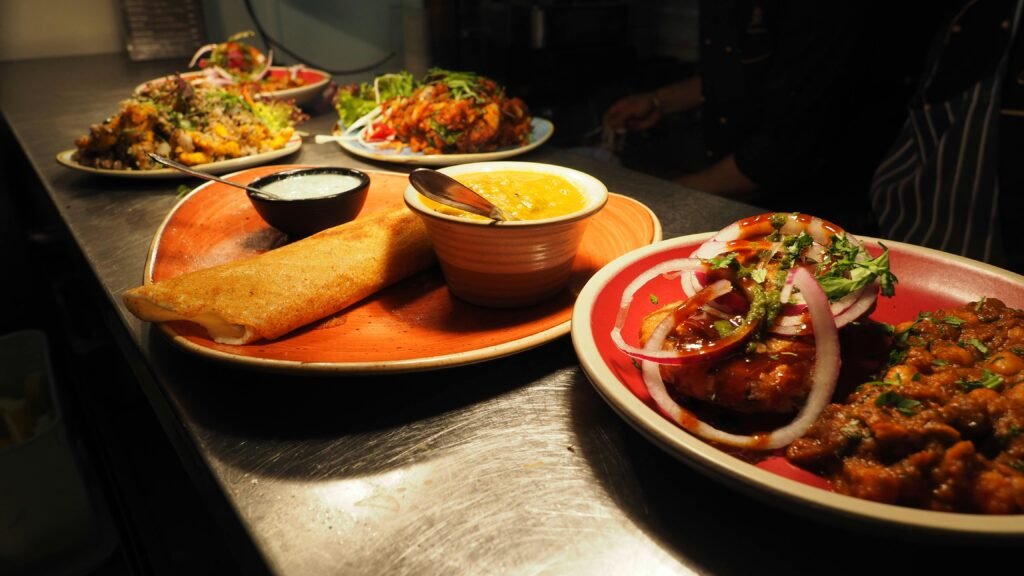Frozen Indian Food
In the realm of culinary delights, Indian cuisine stands out for its vibrant flavors, aromatic spices, and rich cultural heritage. While enjoying authentic Indian dishes traditionally involves meticulous preparation, the advent of frozen Indian food has revolutionized the way enthusiasts savor these delectable flavors. Let’s embark on a journey through the frozen aisles and uncover the allure of frozen Indian food, where convenience meets authenticity in every bite.
Table of Contents
The Convenience of Ready-to-Eat Delights
In today’s fast-paced world, convenience is king, and frozen Indian food delivers just that. With a diverse array of options ranging from savory curries to tantalizing appetizers, frozen Indian food offers a convenient solution for busy lifestyles without compromising on taste or quality. Whether you’re craving a quick meal or hosting a dinner party, these frozen delights provide a hassle-free culinary experience that’s ready in minutes.
Preserving Authentic Flavors and Ingredients
One might wonder, does frozen Indian food truly capture the essence of traditional cuisine? The answer lies in the meticulous selection of ingredients and the artful blend of spices that define Indian cooking. From fragrant Basmati rice to tender meats and aromatic sauces, frozen Indian food is crafted with care to preserve the authenticity of each dish.
A Culinary Adventure at Your Fingertips
For those eager to explore the diverse flavors of Indian cuisine, frozen meals serve as a gateway to culinary discovery. With options ranging from classic favorites like Chicken Tikka Masala and Palak Paneer to regional specialties such as Hyderabadi Biryani and Punjabi Dal Makhani, there’s something to tantalize every palate. These frozen treasures allow food enthusiasts to embark on a culinary adventure without leaving the comfort of home.
Nutritious and Wholesome Choices
Contrary to common misconceptions, frozen Indian food can be a nutritious and wholesome option for discerning consumers. Many manufacturers prioritize quality ingredients and avoid artificial additives, ensuring that each meal is not only delicious but also nutritious. With a focus on balanced nutrition and authentic flavors, frozen Indian food offers a guilt-free indulgence that satisfies both the palate and the soul.

Embracing Innovation Without Compromise
In a world where innovation often comes at the expense of authenticity, frozen Indian food strikes a delicate balance between tradition and modernity. While embracing innovative packaging and cooking techniques, manufacturers remain steadfast in their commitment to preserving the time-honored recipes and culinary techniques that define Indian cuisine. The result is a harmonious fusion of tradition and innovation that caters to the evolving tastes of consumers worldwide.
Related: Frozen Indian Food Images
How To Export Frozen Food from India
Exporting frozen food from India involves several steps and compliance with regulatory requirements. Here is a general guide to help you understand the process:
1. Market Research and Product Selection:
- Conduct thorough market research to identify potential markets and demand for your frozen food products.
- Choose specific products that align with the target market preferences.
2. Quality and Regulatory Compliance:
- Ensure that your frozen food products comply with quality standards and regulations in both India and the target export market.
- Obtain necessary certifications such as Food Safety and Standards Authority of India (FSSAI) for compliance with Indian regulations.
3. Business Registration:
- Register your business with the relevant authorities, such as the Directorate General of Foreign Trade (DGFT) in India.
4. Obtain Importer-Exporter Code (IEC):
- Acquire an IEC from the DGFT, which is mandatory for anyone wishing to carry out import/export activities in India.
5. Packaging and Labeling:
- Ensure that your frozen food products are packaged securely to maintain quality during transportation.
- Label the products in compliance with the regulations of the destination country, including nutritional information, ingredients, and any required language translations.
6. Cold Chain Logistics:
- Establish a reliable cold chain logistics system to maintain the required temperature for frozen food products during transportation.
- Choose reputable shipping companies or freight forwarders experienced in handling frozen goods.
7. Export Documentation:
- Prepare necessary export documentation, including:
- Commercial Invoice
- Packing List
- Bill of Lading or Airway Bill
- Certificate of Origin
- Phytosanitary Certificate (if required)
- Health Certificate (if required)
8. Customs Clearance:
- Work with customs brokers to facilitate the smooth clearance of your goods through customs in both India and the destination country.
9. Compliance with Import Regulations:
- Familiarize yourself with the import regulations and requirements of the destination country.
- Ensure compliance with any import permits, licenses, or restrictions.
10. Build Relationships with Distributors:
- Establish relationships with distributors, wholesalers, or retailers in the target market to facilitate the distribution of your frozen food products.
11. Promotion and Marketing:
- Develop a marketing strategy to promote your frozen food products in the target market.
- Participate in trade shows or events to showcase your products to potential buyers.
12. Post-Sale Support:
- Provide excellent customer service and post-sale support to build a positive reputation in the export market.
Important Considerations:
- Stay informed about changes in regulations and requirements in both India and the target market.
- Seek assistance from export promotion councils or trade associations for guidance and support.
- Work with experienced professionals, such as customs brokers and logistics providers, to navigate the complexities of international trade.
It’s advisable to consult with export professionals, legal experts, and trade organizations to ensure compliance with all relevant regulations and to maximize the success of your frozen food export venture.
How to Start Frozen Food Business in India
Starting a frozen food business in India involves careful planning, compliance with regulations, and strategic considerations. Here’s a step-by-step guide to help you kickstart your frozen food venture:
1. Market Research:
- Conduct thorough market research to identify the demand for specific frozen food products in your target region.
- Analyze competitors and understand consumer preferences.
2. Business Plan:
- Develop a comprehensive business plan outlining your business objectives, target market, product range, marketing strategy, and financial projections.
3. Legal Requirements:
- Register your business entity and obtain necessary licenses, including Food Safety and Standards Authority of India (FSSAI) registration.
- Comply with local, state, and central government regulations for food businesses.
4. Location and Infrastructure:
- Choose a suitable location for your business, considering factors such as proximity to transportation hubs, storage facilities, and potential customers.
- Set up a cold storage facility with the necessary equipment to maintain the required temperature for frozen food products.
5. Product Selection:
- Determine the range of frozen food products you want to offer. Consider popular choices in the market and assess the feasibility of producing or sourcing these items.
6. Supplier Relationships:
- Establish relationships with reliable suppliers or manufacturers for sourcing raw materials or finished frozen products.
- Ensure that your suppliers adhere to quality standards and can meet your quantity requirements.
7. Quality Control:
- Implement stringent quality control measures to ensure the freshness and safety of your frozen food products.
- Adhere to hygiene and sanitation standards in production and storage areas.
8. Packaging and Branding:
- Invest in attractive and durable packaging for your frozen products. Ensure that packaging complies with food safety regulations.
- Develop a strong brand identity that communicates the quality and uniqueness of your frozen food offerings.
9. Distribution and Logistics:
- Set up an efficient distribution network to reach your target market.
- Establish partnerships with reliable logistics and transportation providers to ensure timely and safe delivery of your products.
10. Marketing and Promotion:
- Develop a marketing strategy to promote your frozen food products. Utilize digital marketing, social media, and traditional advertising methods.
- Offer promotions, discounts, or introductory offers to attract customers.
11. Compliance with Retail Channels:
- If targeting retail channels, ensure compliance with packaging and labeling requirements set by supermarkets and grocery stores.
12. Technology Integration:
- Consider implementing technology solutions for inventory management, order processing, and customer relationship management.
13. Build Online Presence:
- Create a user-friendly website and leverage e-commerce platforms to reach a wider audience.
- Consider partnering with food delivery platforms to expand your reach.
14. Customer Feedback and Adaptation:
- Encourage customer feedback and reviews to understand their preferences and improve your offerings.
- Stay flexible and adapt to changing market trends and consumer demands.
15. Continuous Improvement:
- Regularly assess and enhance your business operations, product quality, and customer service.
- Stay informed about industry trends, innovations, and regulatory updates.
Launching a frozen food business in India requires a combination of strategic planning, compliance with regulations, and a commitment to delivering quality products. Keep in mind that the success of your venture will depend on your ability to meet consumer expectations and navigate the dynamic food industry landscape.
Related: Indian Frozen Food Store
Are Frozen Foods Sold in India
Yes, frozen foods are sold in India, and the market for frozen food products has been growing steadily. The availability and consumption of frozen foods have increased due to various factors such as changing lifestyles, urbanization, and the rising demand for convenience. Consumers in India are increasingly looking for time-saving solutions without compromising on the quality and taste of their meals.

Frozen foods in India encompass a wide range of products, including:
- Frozen Vegetables: Various vegetables like peas, corn, spinach, mixed vegetables, and more are available in frozen form.
- Frozen Fruits: Fruits like berries, mangoes, and mixed fruit blends are commonly found in the frozen section.
- Frozen Snacks and Appetizers: Ready-to-cook and ready-to-eat frozen snacks such as samosas, spring rolls, and kebabs are popular choices.
- Frozen Meat and Seafood: Frozen chicken, fish, prawns, and other seafood products are widely available.
- Frozen Meals and Entrees: Pre-packaged frozen meals, including curries, biryanis, and international cuisines, cater to consumers looking for quick and convenient options.
- Frozen Desserts: Ice creams, frozen yogurts, and other frozen desserts are perennial favorites.
Major supermarkets, hypermarkets, and grocery stores across urban and semi-urban areas stock a variety of frozen food products. Additionally, online platforms and specialty stores also contribute to the accessibility of frozen foods for consumers.
It’s important to note that the market for frozen foods in India continues to evolve, and consumers are becoming more discerning about the quality and nutritional aspects of these products. The industry has responded by introducing innovative and healthier frozen food options to meet the changing preferences of the Indian consumer.
In Conclusion
Frozen Indian food represents more than just a convenient meal option; it’s a celebration of culture, flavor, and tradition. With its diverse array of options, commitment to authenticity, and unparalleled convenience, frozen Indian food invites enthusiasts on a culinary journey that transcends borders and embraces the rich tapestry of Indian cuisine.
So the next time you find yourself craving the flavors of India, venture into the frozen aisle and discover a world of culinary delights waiting to be savored. With each bite, experience the magic of frozen Indian food—a symphony of taste, tradition, and convenience that captivates the senses and nourishes the soul.
Thanks for Watching Prime Reviews

